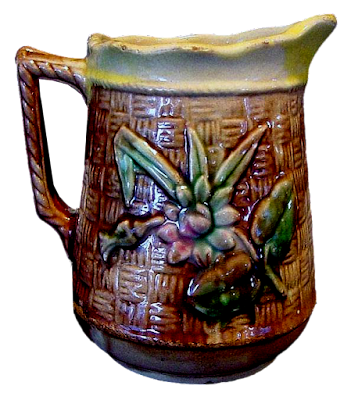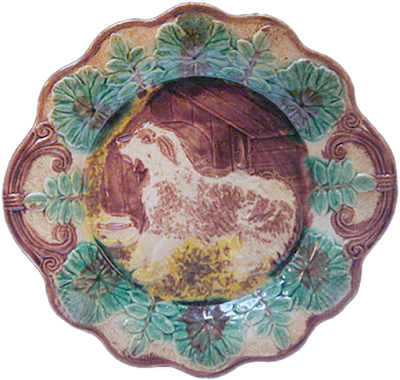Walk into just about any antiques shop or co-op in the U.S. that carries pottery and you're likely to encounter the work of the Arsenal Pottery. The pottery was abundant and inexpensive at the time that it was made and has remained easily available to just about anyone who might be interested for the past 110 years. Yet, the Arsenal Pottery is one of the least well known names in majolica. What happened?
What happened is that not much was known about the majolica of the Arsnal Pottery until relatively recently. It is only because of the accidental discovery of shards of majolica from the shores of the Delaware River that we now know the manufacturer of the majolica that has graced our homes for all this time.
Mayer Brothers c. 1885
The pottery began in 1869 as a division of the Joseph Mayer Pottery Manufacturing Company of Trenton, NJ. Mayer was an English potter who emigrated to the United States in 1865 to seek his fortune in the booming American pottery trade. The pottery at various times operated under several different names: Joseph Mayer's Arsenal Pottery, Mayer Brothers, Arsenal, Mayer Arsenal, Joseph Mayer, Mayer Company, Mayer Pottery Company, and Mayer Manufacturing Company but for the sake of this post we will refer to it as the Arsenal Pottery. Under this name Mayer opened his pottery in 1876.
Location of the Arsenal Pottery in Trenton
The Arsenal Pottery was located on Temple Street at the corner of Third Street and ran the length of the block to Schenck Street in Trenton, an area conveniently located three blocks from the Trenton Channel of the Delaware River. It consisted of several three and four story brick buildings approximately 250 feet by 300 feet in size.
The pottery had four large kilns as well as a smaller decorating kiln.
Arsenal Pottery layout c.1890
Mayer began by specializing in yellow ware, tile and treacle glazed Rockingham ware for domestic use. In 1878 his brother James joined the operation and by the early 1880's the Mayer brothers expanded their wares by adding majolica and Barbotine wares to their line in addition to porcelain and ironstone ware.
Arsenal Rockingham pitcher
Arsenal Rockingham teapot Rebekah At The Well
Arsenal Uncle Sam pitcher
Trade advertisement for the Arsenal Pottery
In a contemporary essay on the potteries of New Jersey, the pottery was described thus:
In the manufacture of Rockingham and Yellow Ware the Mayer Brothers excel. Their manufactures consist of the colored pottery known as Rockingham and Yellow Ware, and include tea and coffee pots, jars, spittoons, dishes, bowls, pans, etc. of superior make and favorably known to the trade of the country. They also manufacture Majolica Ware, and are importers of printed and decorated ware of various kinds.”
— Industries of New Jersey, Trenton, Princeton, Hightstown, Pennington and Hopewell. 1882.
The majolica produced at Arsenal are some of the most commonly found designs seen in U.S. majolica. A page from the company's advertising catalog shows some of the designs.
Arsenal majolica bird’s nest pitcher,
a copy of Shorter & Boulton
Arsenal Pottery fish plate
Arsenal Pottery oak plate
Arsenal Pottery geranium plate
Arsenal Pottery cuspidor
Arsenal Pottery majolica canister
Arsenal Pottery majolica corn creamer
Arsenal Pottery majolica plate
Arsenal Pottery majolica plate
Arsenal Pottery majolica plate
Arsenal Pottery majolica plate
Arsenal Pottery majolica blackberry plate
Arsenal Pottery majolica plate
Arsenal Pottery majolica plate
Arsenal Pottery majolica pond jug
Arseal Pottery copy of a Wedgwood pitcher
Arsenal Pottery majolica shell pitcher
Arsenal Pottery majolica plate
Arsenal Pottery majolica plate
Arsenal Pottery majolica dog plate
Arsenal Pottery majolica dog plate
Arsenal marked their ironstone but almost none of their majolica. The two exceptions I can speak of from my own experience are in the Arsenal owl paperweight which I have seen marked with the Mayer name, and a green leaf dish which was marked Mayer in a script font.
Arsenal owl paperweight marked MAYER |
Reverse of the owl paperweight
This lack of markings is one of the reasons the identity of these pieces was unknown for so long. It was only until the earlier mentioned excavations that the connection was made with Arsenal.
In 1884 the Mayer Pottery submitted to the New Orleans Cotton Centennial Exhibition an elaborate piece of majolica for prize consideration. While the ceramics prize that year went to Griffen, Smith & Company of Phoenixville, PA. instead, the majolica pieces shown exhibit the company's dexterity with the majolica form.
Arsenal pottery vase exhibited to the 1884 New Orleans Exhibition |
Arsenal Pottery is easy to find and relatively inexpensive. It has remained a favorite with decorators looking to add a bit of rustic charm to country interiors.
Despite its availability, the work of Arsenal is being liberally reproduced today. The quality of some reproductions are exceptionally good. The Toby plate, the Blackberry plates and the Stag and Dog plate reproductions are so good they have fooled both dealers and collectors.
Reproduction Arsenal dog and stag plate
Reproduction Arsenal drinking man plate
Reproduction Arsenal blackberry plate
Other pieces being reproduced today are easily discernible from the originals: the floral pitchers; birds nest pitchers; pond lily pitchers; maple leaf plates; and bark and flower pitchers. One design, the small daisy pitcher is marketed with a phony Etruscan Majolica seal on the underside.
Made by Majolica Wares, these small creamers are clearly marked
with a script MW on the base
Reproduction lily pitcher
The production of majolica continued at Arsenal at least until 1894. When Edwin Atlee Barber published his book, The Pottery and Porcelain of the United States he commented that at that time Arsenal was the only pottery in the country still potting majolica. The Mayers sold the pottery in 1905.
This post has been updated since its original publication





















































No comments:
Post a Comment